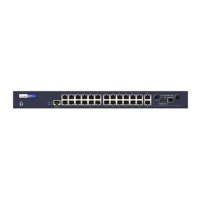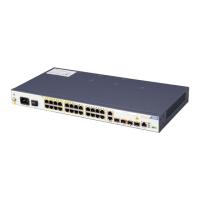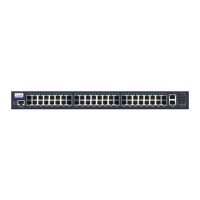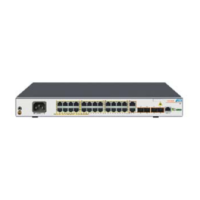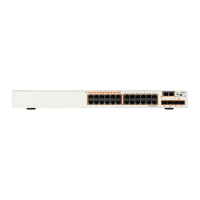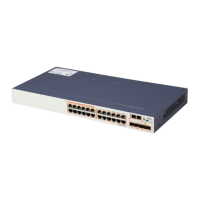
Do you have a question about the Zte ZXR10 2928E and is the answer not in the manual?
| MAC Address Table Size | 8K |
|---|---|
| Jumbo Frame | 9K |
| Storage Temperature | -40°C to 70°C |
| VLAN | 4K |
| Power Supply | AC: 100~240V, 50/60Hz |
| Dimensions | 440mm x 44mm x 220mm |
| Operating Temperature | 0°C to 45°C |
| Operating Humidity | 10% to 90% non-condensing |
| Storage Humidity | 5% to 95% non-condensing |
| Power Consumption | < 30W |
ZXR10 2900E provides several configuration modes, select a configuration mode according to the network connected.
Commands are allocated to different modes according to functions and authorities. A command can be executed only in the specified mode.
The common command parameters of ZXR10 2900E are listed in Table 2-1.
In any command mode, enter a question mark (?) behind the DOS prompt of the system for online help.
FLASH memory is the major storage device. Version and configuration files are saved here.
Back up or restore version and configuration files using TFTP server.
Back up or restore version and configuration files using FTP server.
Provides configuration information import/export function for easy configuration and management.
Refers to saving configuration and version files in FLASH memory.
Automatic software version download function for undeployed devices.
Uploads switch configurations to the back end automatically.
Procedure for upgrading software version when the system is normal or abnormal.
Lists commands for file system configuration, including directory and file operations.
Covers mode switch, console attribute, global information, and switch user access configuration.
Configures port parameters including auto-negotiation, duplex mode, rate, and line detection.
Details Power over Ethernet (PoE) features and configuration.
Mirrors data packets from switch ports to destination ports for monitoring.
Configures Virtual Local Area Networks (VLANs) for segmenting network traffic.
Manages MAC addresses, aging time, filtering, and learning.
Configures Link Aggregation Control Protocol (LACP) for bundling multiple physical links.
Optimizes multicast traffic forwarding by snooping IGMP messages.
Manages multicast traffic in IPv6 environments using MLD snooping.
Enables and configures Internet Protocol Television (IPTV) services.
Configures Spanning Tree Protocol (STP) to prevent network loops.
Configures Access Control Lists (ACLs) to filter network traffic based on defined criteria.
Manages Quality of Service (QoS) to prioritize and control network traffic.
Configures Private VLANs (PVLANs) to enhance network security by isolating ports.
Enables transparent transmission of Layer 2 protocols like STP, LACP, and 802.1x.
Configures IPv4 layer-3 functions for remote access and routing.
Supports IPv6 layer-3 functions for remote configuration and management.
Configures Dynamic ARP Inspection (DAI) to prevent ARP spoofing attacks.
Manages network access subscribers using 802.1x and RADIUS protocols.
Configures MAC authentication for devices that do not support 802.1x clients.
Configures QinQ (VLAN stacking) for tunneling VLAN traffic.
Configures Syslog to manage and classify system information and logs.
Configures Network Time Protocol (NTP) for clock synchronization between devices.
Configures Generic Attribute Registration Protocol (GARP) and GARP VLAN Registration Protocol (GVRP).
Configures DHCP for dynamic IP address assignment and DHCP snooping.
Configures DHCPv6 for dynamic IPv6 host configuration and security features.
Configures Virtual Broadband Access Server (VBAS) for wide-band user identifier management.
Configures PPPoE-PLUS for user location information insertion.
Configures ZTE Ethernet Smart Ring (ZESR) for network reliability and fault convergence.
Configures Operation Administration Maintenance (OAM) for Ethernet link monitoring.
Configures SQinQ for multi-point to multi-point VLAN transparent transportation.
Implements VLAN convergence by mapping customer VLANs to service provider VLANs.
Configures sFlow for monitoring high-speed data transmission networks.
Configures Protocol Protect (PP) to prevent attacks and ensure network security.
Configures Link Layer Discovery Protocol (LLDP) for neighbor discovery.
Checks for loops on switch ports and disables ports to prevent broadcast storms.
Configures UniDirectional Link Detection (UDLD) for logical link detection.
Configures Terminal Access Controller Access-Control System Plus (TACACS+) for AAA.
Configures time ranges for applying policies based on specific time conditions.
Allocates a dedicated VLAN for voice data to improve call quality.
Configures Connectivity Fault Management (CFM) for virtual bridge LAN fault detection.
Defines extensions for CFM to measure network link status and performance.
Decides VLAN for untagged frames based on source MAC address.
Configures DHCP Relay Agent to forward IP address requests between clients and servers.
Restricts network management access to specified IP addresses for enhanced security.
Configures Secure Shell (SSH) for secure remote access and data transmission.
Levels command lines and grants different permissions to users.
Covers Simple Network Management Protocol (SNMP) for network monitoring.
Details Remote Monitoring (RMON) for subnet behavior monitoring.
Configures ZTE Group Manage Protocol (ZGMP) for cluster management.
Configures sFlow for monitoring high-speed data transmission networks.
Manages the switch using a web browser via the embedded web server.
Displays key statistics and events through panel indicators for device maintenance.
Configures Telnet for remote internet login service and switch operations.
Covers daily and monthly maintenance tasks for the switch.
Uses VCT (Virtual Line Detection) to diagnose line faults.
Provides procedures for handling common hardware and software faults.


